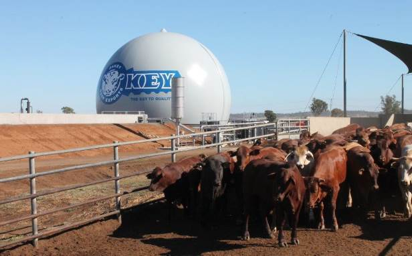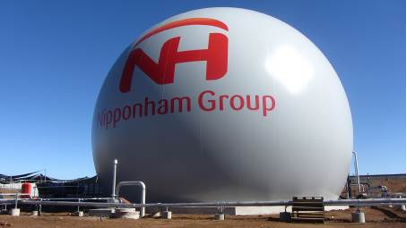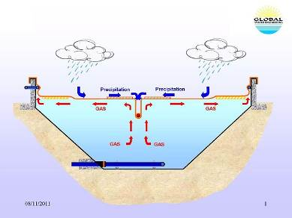A spectacular orb-shaped green energy storage facility being installed at one of Australia’s largest beef processing plants is helping to demonstrate how industry can profit from environmental initiatives. The 6000m3 capacity flexible PVC-coated polyester fibre flexible storage tank collects biogas produced by the new Global Water Engineering COHRAL™ Covered High Rate Anaerobic Lagoon being installed by CST Wastewater Solutions at Oakey Beef Exports on Queensland’s Darling Downs.

To be commissioned next year, the plant will extract green energy biogas (methane) from its waste water streams to replace millions of dollars worth of natural gas currently consumed at the abattoir.
The 26m high flexible storage tank – one of the world’s largest of its type – features resilient flexible double membrane storage so that gas produced by the COHRAL plant can be safely stored separately from the gas generator. Use of the separate flexible tank for gas storage provides security against leakage, with gas securely contained in the tank instead of being more loosely contained under lagoon covers.
The Sattler biogas storage design selected for Oakey Beef has been tested and proven over decades and now is an integral feature in the design of modern waste water treatment plants worldwide. They are engineered to be permanently gas-tight with high operational reliability and optimum safety.
“The safe, durable and environmentally harmonious COHRAL™ technology deployed at Oakey Beef can be widely applied worldwide to food, beverage and agricultural and primary processing plants. Oakey Beef Processing and its owners Nippon Meat Packers have taken a far-sighted initiative that opens the way to cleaner, greener and more profitable industry performance,” says CST Wastewater Solutions Managing Director Mr Michael Bambridge, whose company represents the GWE COHRAL™ technology in Australia and New Zealand.

In addition to lowering the plant’s dependence on increasingly expensive supplies of natural gas, the Global Water Engineering anaerobic digestion plant will simultaneously reduce the plant’s carbon footprint and produce waste water far cleaner than typical waste lagoons.
The installation of the GWE COHRAL™ technology by Australian environmental engineering and green energy authority CST Wastewater solutions is the first GWE COHRAL™ installation in the world, deploying for the first time in a covered lagoon GWE anaerobic technology proven in more than 300 reactor (tank) installations worldwide.
COHRAL™ technology – which is applicable to both livestock and cropping operations – uses concentrated anaerobic bacteria to digest 70 per cent of the organic matter (COD, or Chemical Oxygen demand) in Oakey Beef Exports’ waste water to produce effluent of far high quality than typical open lagoons.

Oakey Beef Exports, which employs 750 people, adheres to Nippon Meat Packers’ strict environmental guidelines and corporate responsibility ethic as a major operator across Australia and an exporter to 34 countries.
Mr Bambridge says Oakey’s initiative sets an outstanding precedent for agribusiness in Australia because the cost-effective technology can turn an environmental problem into profit by simultaneously enhancing water quality and lowering fuel bills.
“And it also helps companies such as Oakey to guard against future price rises in the cost of energy and possible future imposts such as a carbon tax,” says Mr Bambridge.
Problem to profit
Another major benefit of covered anaerobic lagoons with efficient green energy storage is that the methane biogas produced is not only prevented from escaping into the atmosphere (where it is many times more damaging than C02 emissions) but is also harnessed to generate energy – rather than waste water plants being heavy consumers of energy in processing and oxygenation.
Oakey Beef Exports’ plant will feature reuse of the biogas in its boilers, where it is initially expected to replace usage of about 50,000 gigajoules natural gas a year.
GWE anaerobic waste water green energy plants have been demonstrated in many applications worldwide to transform wastewater from a problematic expense to a profitable resource, says Mr Bambridge.
Under the leadership of GWE President and CEO Mr Jean Pierre Ombregt, GWE’s anaerobic waste water technology has been proved worldwide at more than 300 installations of totally enclosed tanks, or reactors. However, this is the first time it has been applied to a covered lagoon, an application where it has enormous further potential in countries with strong agribusiness sectors.
“In addition to the obvious waste-to-energy benefits, the process also helps curb odours that emanate from open lagoons in processing plants,” says Mr Bambridge. “This is becoming a much bigger issue in Australasia and other countries worldwide as urban encroachment means agribusiness and expanding communities are located much closer to each other than previously.
“So instead of open lagoons being potential dumping grounds for environmental problems, closed installations such as Oakey Creek’s represent an outstanding contribution to good community relations.
“Yet another outstanding benefit is that anaerobic digestion produces reliable and predicable base load power – unlike some other green energy technologies, it is not dependent on the wind blowing or the sun shining.”
COHRAL™ Covered Lagoons
COHRAL™ installations with secure gas storage represent a major advance over open lagoons and are suitable for solutions involving less technology-intensive applications that allow a long process residence time and where adequate space is available.
COHRAL™ anaerobic lagoons consist of two zones, with the complete surface of the lagoon being covered with an influent distribution system.
The first and largest zone receives the major part of the incoming wastewater. This reaction zone is where the anaerobic digestion occurs.
The second, smaller part of the lagoon serves as a post-digestion and pre-settling zone where a partial clarification of the effluent wastewater takes place. Settled sludge collected in this zone is pumped back to the inlet of the lagoon.
Part of the anaerobic effluent is recycled back to the lagoon. The remaining effluent of the lagoon flows by gravity towards complementary technology such as the GWE proprietary SuperSep-CFS separation technology being used in the first Australian installation.
Simplicity and energy efficiency are keynotes of the COHRAL™ system, with no additional mixing facilities required in the anaerobic lagoon. The influent distribution system acts as a hydraulic mixing system, converting a standard low load/low efficiency lagoon into a COHRALTM system with increased efficiency.
Sattler double-membrane gas storage tanks
The Sattler biogas storage design selected for Oakey beef has been tested and proven over decades and now is an integral feature in the design of modern waste water treatment plants worldwide. They are engineered to be permanently gas-tight with high operational reliability and optimum safety.
The Sattler double membrane gas storage tank consists of an external membrane which forms the outer shape of the tank, as well as an internal membrane and a bottom membrane which make up the actual gas space.
A permanently running support air blower provides air to the space between inner and outer membrane, and thus keeps the gas pressure up at a constant level – irrespective of gas supply and gas withdrawal.
Biogas storage systems are an active contribution to the generation of renewable energies, and thus to environmental protection in general. At Sattler, concepts for the storage of biogas, liquid manure, or brewery residues have a long tradition. In 1981 SATTLER invented the double membrane gas holder for storing digester gas from waste water treatment plants.
Anaerobic digestion for green energy
Anaerobic digestion facilities have been recognised by the United Nations Development programme as one of the most useful decentralised sources of energy supply, as they are less capital-intensive than large power plants. They can also benefit local communities by providing local energy supplies and eliminate the need for large and often smelly and environmentally challenging settling lagoons.
Good solutions do not have to be extortionately expensive and can be staged:
– A satisfactory first step in many instances can be taken by covering lagoons and incorporating anaerobic processes with properly engineered feed and recycle systems, such as those in the COHRAL™ process.
– A second progressive step can involve the use of tanks to contain anaerobic and other processes, minimising land use, reducing plant footprints and providing high security against leaks and groundwater contamination. Anaerobic processes can also be more closely efficiently controlled in such close environments, optimising water purification and green energy production.
– A third optimum stage can be the eventual incorporation of the most advanced anaerobic technologies into sealed tank environments, such as GWE’s RAPTOR™ treatment system for organic residues, for example, which can convert almost any organic residue or energy crop into biogas, valuable electricity or heat.
